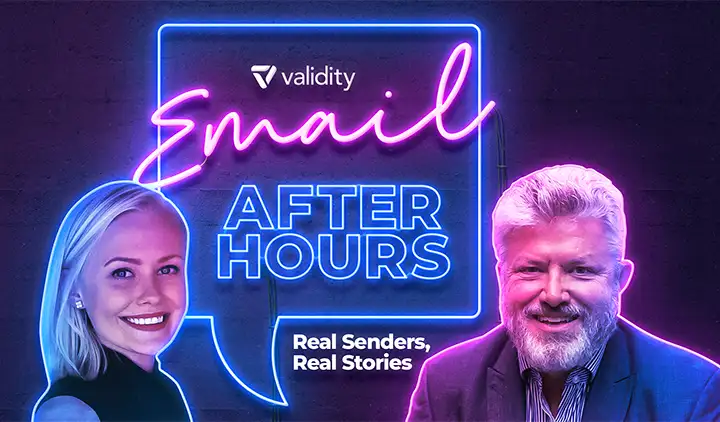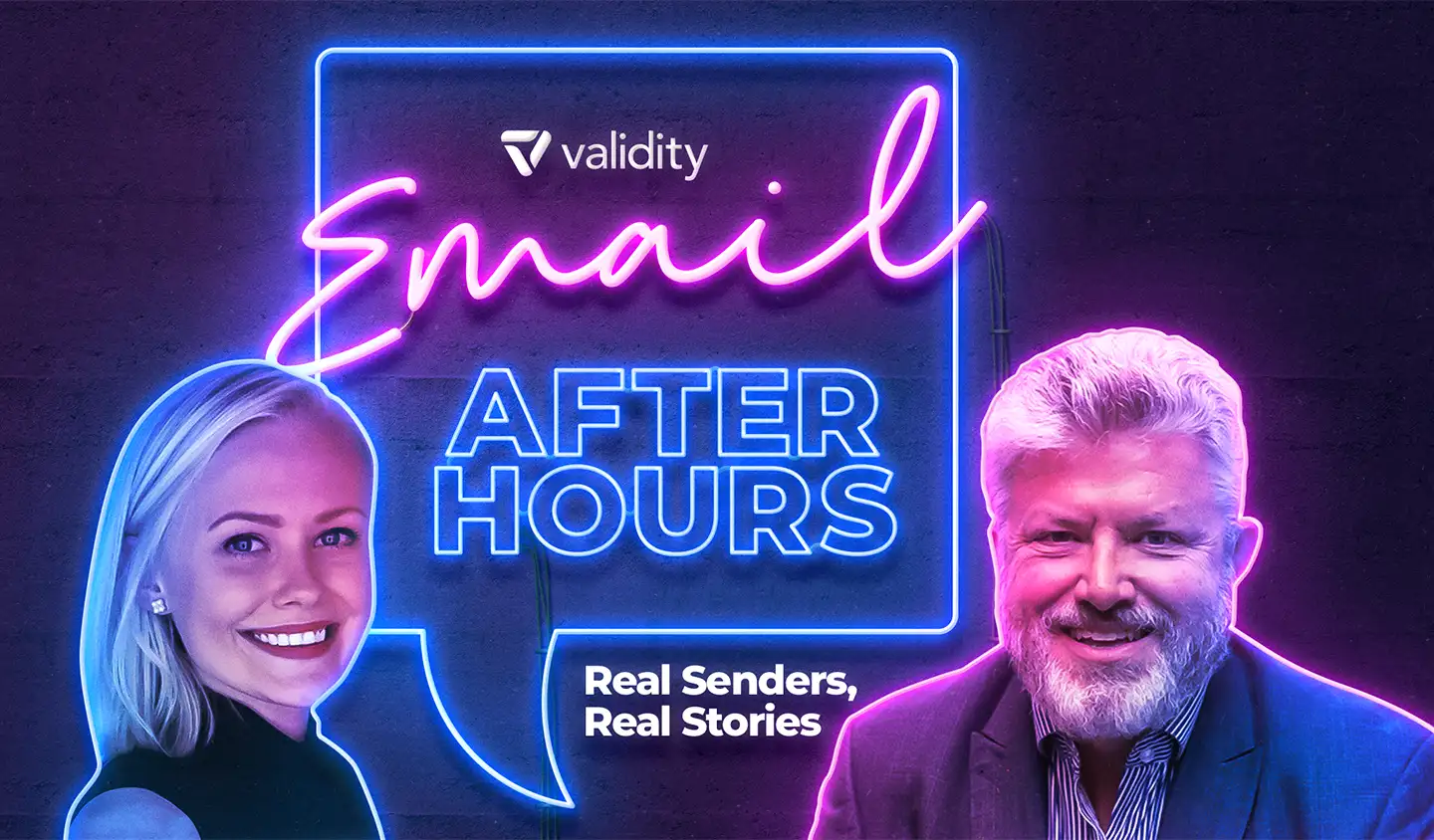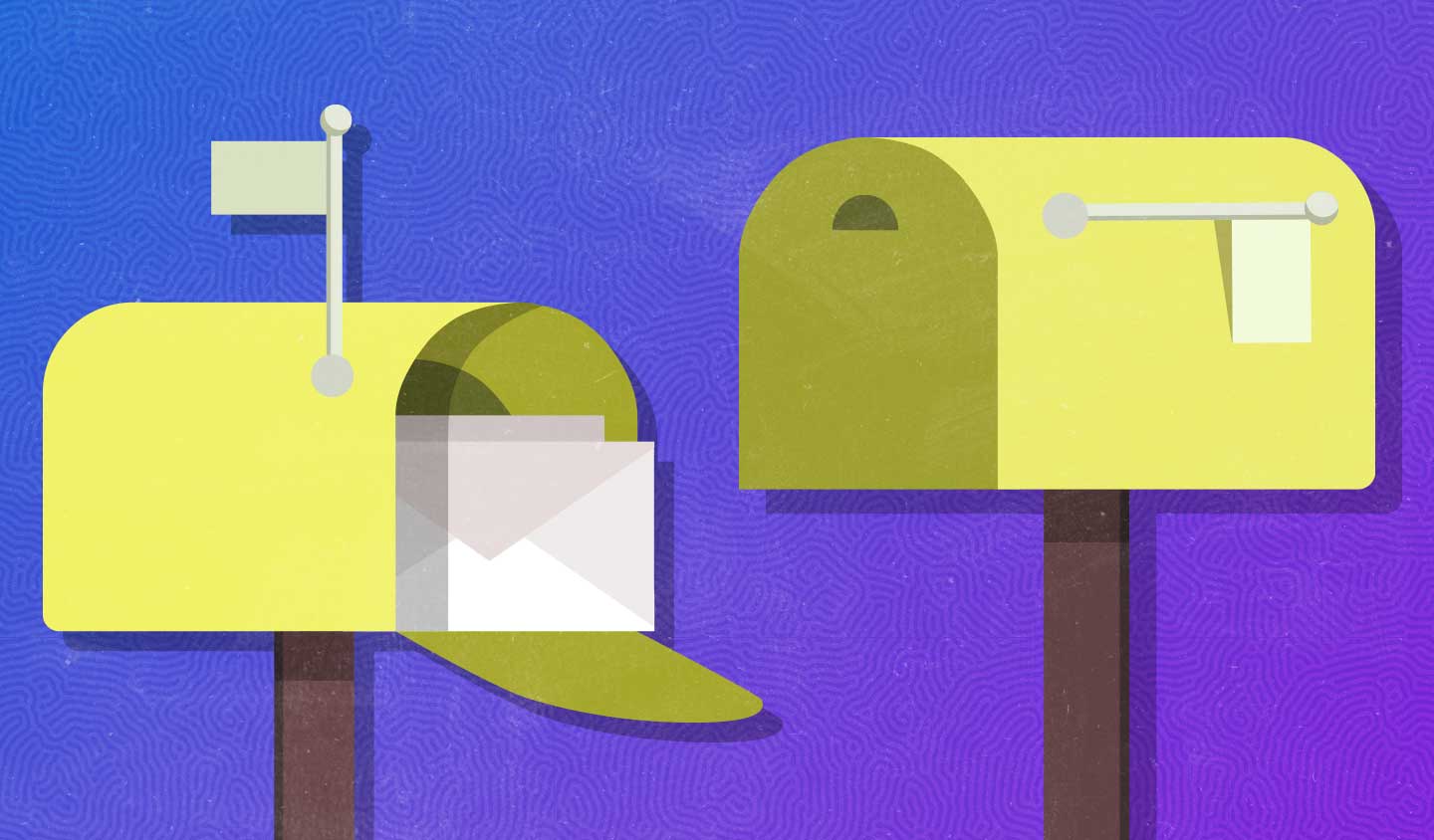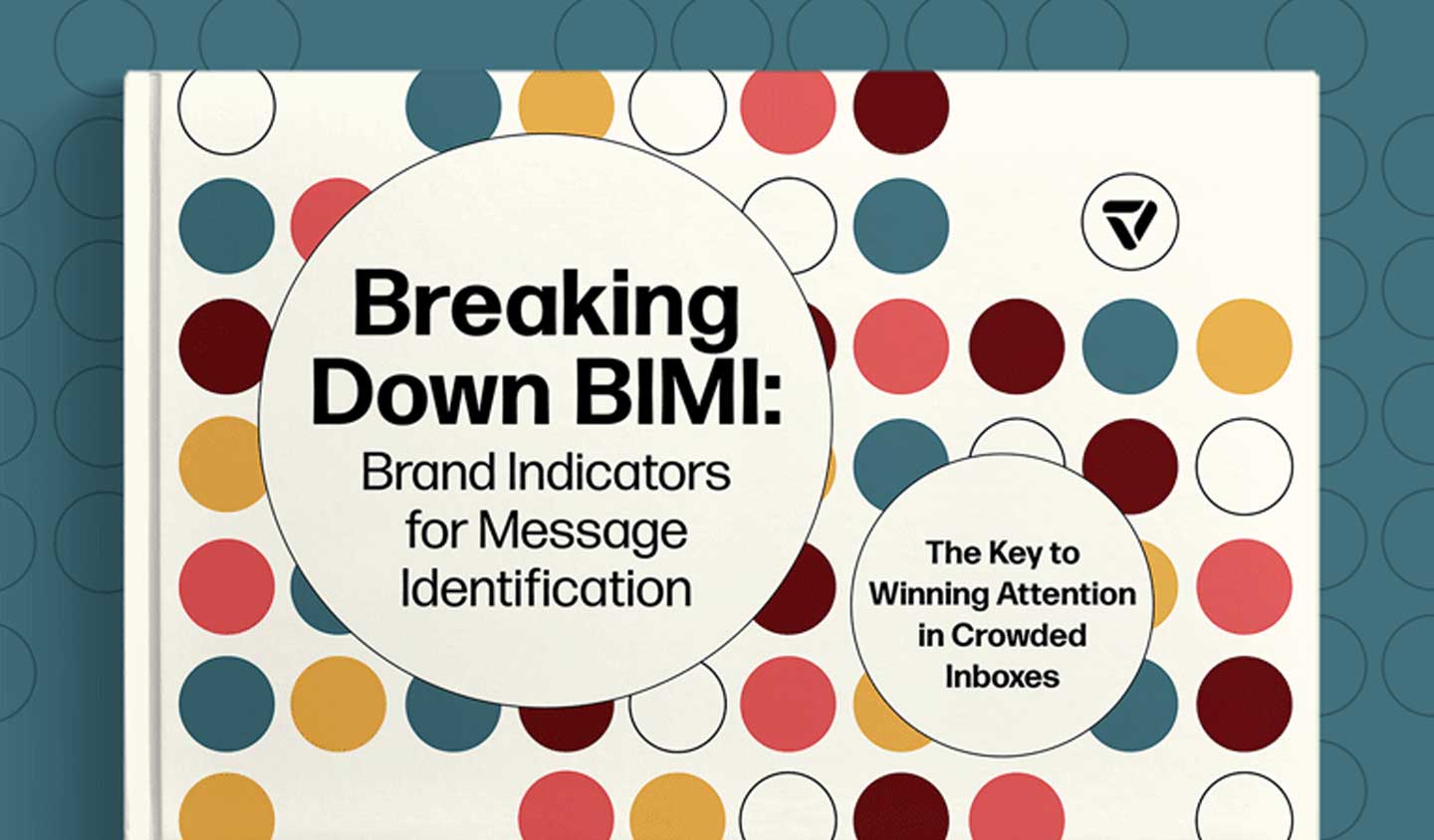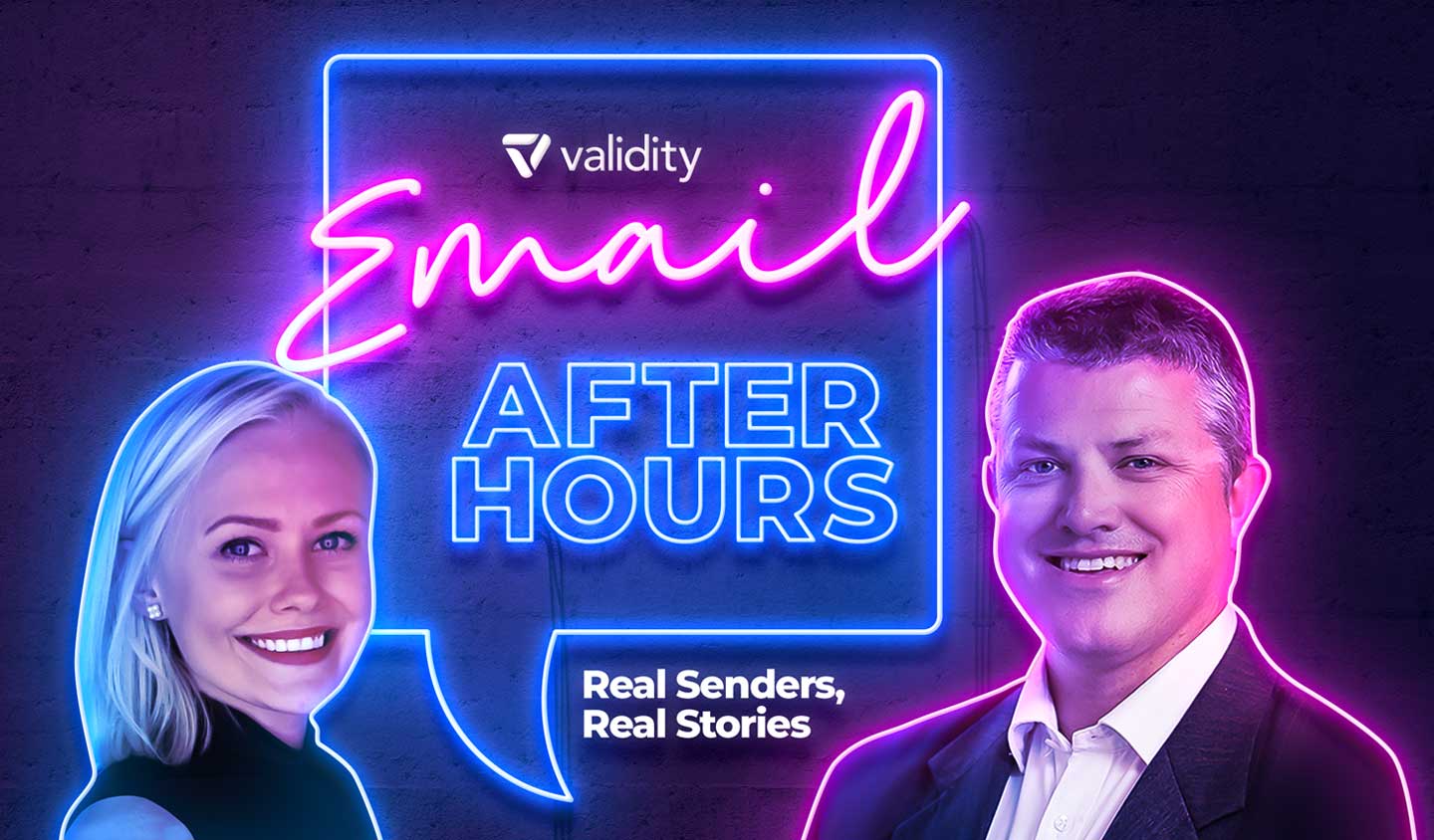Danielle Gallant – 00:00:00:
Welcome to Email After Hours by Sender Score, powered by Validity.
Guy Hanson – 00:00:09:
We’re your hosts. My name is Guy Hanson.
Danielle Gallant – 00:00:10:
And I’m Danielle Gallant. And this is Email After Hours. Today, we’re here to talk about e-commerce. E-commerce has exploded over the last decade, particularly during COVID-19, when in-person retailers were forced online. Naturally, this e-commerce burst has had massive implications on the world of email. We know that global email marketing volumes have doubled compared with pre-pandemic levels. As the channels consumers use to shop and interact with brands multiply, it can be difficult to keep the customer journey clean and consistent. Since e-commerce is definitely here to stay, let’s get to the bottom of how marketers can use email to create a better e-commerce buying experience.
Guy Hanson – 00:00:58:
And to help us with that conversation today, it’s a real pleasure to welcome our very special guest, Michael Affronti. Now, Michael, you work for Commerce Cloud, which is part of Salesforce. Tell us what that means in terms of what you do for your day job.
Michael Affronti – 00:01:13:
Oh, great question. And wonderful to see you guys, and thanks so much for having me on today. So I’m Michael Afronti. I’m the general manager of Commerce Cloud, which is a division of Salesforce. My responsibility and what my team and I deliver is the commerce technology that our customers use to help them grow and maintain digital revenue streams. We started out over 15 years ago as an independent company called Demandware, and then all of that came into Salesforce about eight or nine years ago. And then since then, we’ve deeply integrated it into the Salesforce platform. And now our key customers in the retail and non-retail industries all over the world use our technology to power their e-commerce storefronts, manage their order fulfillment, and integrate it into both marketing cloud and all of our other clouds to deliver personalization across the entire buyer journey.
Guy Hanson – 00:01:58:
Wow. That’s a great overview. Thanks so much. So I think we, as a business, take a particular interest in e-commerce because a key part of that is the email channel. And we’re definitely looking forward to chatting you today about the overlap between the two.
Danielle Gallant – 00:02:12:
And Michael, you’ve been in sales, marketing, and product development for over 19 years. In your opinion, what’s the number one way consumer expectations or behavior has changed?
Michael Affronti – 00:02:24:
Yeah. I was at a conference about a week ago in Amsterdam. We were actually running a conference. It was called A New Day in Commerce and that was actually one of the main topics that I chatted about both on stage and in some of the side chats that we have with the customers we’re meeting with, which is what is the consumer demand right now? The experience that they want. And I think, if you remember, back to the consumerization of IT, from a technology perspective, that was a big watershed moment for consumers and marching with their feet, if you will, to apps and things that IT hadn’t mandated because they delivered a much more consumerized and fun experience. And I think there’s a similar sort of pattern happening over the last, especially two, three years broadly with commerce, but you can fold it into marketing and commerce, which is buyers are now demanding a degree of personalization for themselves that did not exist even a few years ago. And I make these specific examples to sort of bookend it of there’s a double digit percentage of conversion that will drop off if a buyer is trying to buy something either in a B2B or B2C scenario and they don’t see their preferred payment method, right? And you think about all of these basis points of conversion drop that can happen for all of these touch points for your buyers across your brand. And the buyer experience that they’re demanding now is that every one of those things, from the payment methods that are available to the colors that are available in their region for a product, are all as personalized as possible. So this broad theme of personalization we feel at Salesforce is driving a really watershed moment in the way that consumers interact with the brands that they love.
Guy Hanson – 00:03:54:
It’s so important and we’re huge fans of personalization and I think that’s one of the reasons we’re excited to talk to you today. I think one of the things we really like about Commerce Cloud is there’s some really smart functionality there that you can use to drive dynamic content and integration of AMP and AI generated user content, all of which delivers great personalization. So how are you seeing your customers using that kind of functionality? Are they adopting it en masse?
Michael Affronti – 00:04:24:
I would say our customers are adopting it. And I think the reason I say it like that is it really depends on the customer type, the industry. I would say how quickly they are adopting it, but also how quickly it is moving across from personalizing the outbound emails that go out as part of the marketing campaign and then they start personalizing some of the promotions that happen on the e-commerce side and then they start moving to more personalized promotions that get pushed out in the emails as opposed to just on the website. So what we see is customers adopting it and then depending on their degree of sophistication with personalization already, sort of a rapid acceleration into personalizing the whole journey, not just specific points on it. And I think that that’s a really powerful thing that our customers take advantage of because we can bring to bear a lot of connected technologies that are required nowadays to deliver that across all the different channels that people are trying to buy things on.
Danielle Gallant – 00:05:16:
And as we mentioned at the top, we saw a major upshift in email activity because of the pandemic as brands were forced online. Guy and I looked at these trends during our State of Email series and it was just went flew right up. In terms of email volume, how are the pressures on e-commerce email senders different than other industry sectors?
Michael Affronti – 00:05:39:
Yeah, this is a really great question. We talk about this a lot with our customers. I think within e-commerce, you have to really be careful about your balance of promotional and transactional emails. Right? And I think that’s where I see a lot of customers, especially post COVID, trying to think about what is the right balance, how do I continue to use email because it is such an appropriate and useful channel, but what is the balance that I want to have between promotional and transactional emails for the customers that I service? And then from the buyer personalization standpoint, if a buyer has expressed a preference on a different channel, so let’s say they interact with your brand on WhatsApp? Or they interact back to a shipping notification over text and they respond back there, are you taking in those signals and actually moving appropriate types of communication for that buyer to the medium that they like so that you can continue to use email for a different method for that buyer? So meaning, I think the broad generalization of just use email for your promotions and then send SMS for your transactional shipping updates, that’s a good way to start. But I think customers are quickly starting to use products like our data cloud to help personalize even the channel choice to make sure that each channel is being used for the most effective type of communication.
Guy Hanson – 00:06:49:
That’s so interesting. And globally, it feels like we lurch from one crisis to the next. Sort of Danielle was alluding to COVID, and just as COVID seems to be sort of finally receding and suddenly we’re in the most pronounced financial crisis that we’ve seen in decades. Any advice to brands that are sort of struggling to hit their targets right now because discretionary spend has been so reduced?
Michael Affronti – 00:07:14:
Yeah, I think it’s a great point. I was talking to a customer, a large retailer in northern Europe last week about this topic, essentially, and the way they said it. I’ll repeat here. They think about it as every touchpoint with a buyer is so valuable. Because of the limited discretionary spending power, but the high ability to switch or the low switching costs of moving between brands. Especially for direct-to-consumer brands. But even for B2B brands, they said they recognize the importance that every single touch point, every email that goes out, even if it’s a transactional notification for shipping, for example, needs to be personalized more than they thought about before. And I just thought that that was a good realization and sort of my answer back to you here, which is every single touch point to a customer, whether it be an abandoned cart notification if they leave your site, and you want to send them an email that says, hey, these two things you left there are on sale. You want to purchase them now? How are you personalizing every touch point? Because again the confluence of lower discretionary income and spending power combined with the ease of switching to different brands or just searching on a generic search engine for a similar product mean you have to nail it every time you talk to a customer whether it be email, WhatsApp, SMS or other. So I think that intersection has making it stronger than it ever was before if that makes sense.
Guy Hanson – 00:08:25:
100%.
Danielle Gallant – 00:08:26:
No pressure guys. You have to nail it every single time. And I totally agree. And actually, as we talk about the connection between the web experience, email, and even SMS and social, tell us why it’s so important to maintain a smooth connection between these different technologies and what are some of the key things for marketers to consider or businesses to consider when they make these integrations?
Michael Affronti – 00:08:51:
Yeah, it’s a great topic. There is a really good report called The State of the Connected Consumer and there was a stat in there 83% of customers say they’re more loyal to companies that provide consistency across departments such as Commerce and Marketing. And while most buyers are not going to think about departments at the company that they’re talking to, I think that stat is really important because that is a very large percentage of customers who say that that connectivity you just talked about is really important. I personally about a month ago my wife and I were going to go fly somewhere within the US for a personal vacation and we had a classic flight delay situation that started the morning but the flight got consequently delayed like three or four more times. We ended up being stuck in the airport. We were generally not having a great day. We ended up getting on a different airline to take a flight that night. I woke up the next morning and I had a promotional email from the first airline in my inbox offering me a vacation package and I joked to my wife because as a consumer I joked to her and I said man, talk about not the right message at the right time. And then the product manager in me went, huh, they must not be talking to each other across these departments, because the service department that a couple of hours later issued me the we’re so sorry about what happened here’s. Some points to say thank you. Like clearly did not talk to the department that blasted me with this big promotion that I was not interested in at all. Ironically I like the airline so I saw smoothed it over and a week later it probably would have been the best time for me to get that promotion. So I tell that story because it A) just happened to me but B) I think it really highlights that you cannot afford to have that happen even once because most people are not as loyal to brands as they are to airlines. So if you can imagine that being more traditional D2C company that has lower brand affinity, you could destroy your relationship with that customer in one move and now you’ve lost them and it’s all because you are blasting out independent promotional emails, or independent emails if you will, from different departments.
Guy Hanson – 00:10:45:
I’m with you. I’ve had a few of those recently. And then to add insult to injury, they’d like book you on another flight tomorrow even though you got to get there today and they’re still really pleased with themselves. It’s like they’ve done you some kind of big favor. It’s a tough customer experience. But I wanted to pick up on what you mentioned just now about the effectiveness of abandonment messages as a sort of great opportunity to nudge that potential buyer to completing the transaction. And Danielle and I are big fans. We love talking about that kind of automation. Do you have anything else in a sort of similar vein when it comes to those really effective techniques that get people into a web store to shop?
Michael Affronti – 00:11:23:
Yeah, I would say it goes back to sort of Mail Merge 101 if you will use the person’s name. Don’t mess up the basic details because how many times have you gotten a promotional email and it says in my case it’ll be Dear Affronti, Michael, and you go, I remember my first mail merge. But I think it does highlight that every detail matters because often those details are the personalization moments themselves, whether it be the person’s name or in my case if I have a nickname or something that I prefer to be known by. But it really does matter, right? So one of the things that we talk to our customers about both in Marketing Cloud and broadly within our marketing and commerce portfolios is making sure that all those details are right and all those details are really done correctly. And I think this gets back to and I don’t want to get too much into our product offerings, but I do think it is important to talk about the user profile that’s driving a lot of this, right? And I think that’s where it used to be okay to generally have different silos of this user information because there was no easy way to bring them together. And then the CDP category emerged and our product offering our data, cloud is really targeted to help our customers solve the problem we’re talking about, which is making sure you’re able to personalize across a multistep journey across different departments as expressed to the customer, and also while not having to rearchitect your entire IT infrastructure to combine everything. Right? Marketing and Commerce can still be in two separate departments but if you’re using a common user profile, it gives you the ability to actually make sure that my name is correct in all those transactional and promotional emails. It also gives the system the ability to say, Michael just had this incident with the delayed flight, so put him into the hold queue for the next promotion and send it out a week later.
Guy Hanson – 00:13:04:
Right?
Michael Affronti – 00:13:04:
And that’s something that is not easily possible if your data stores about your people are kind of scattered all over your company.
Danielle Gallant – 00:13:10:
I mean, for sure an ineffective email marketing strategy or SMS strategy can lead to customers abandoning the offending e-commerce site. And we’ve talked about a couple of obvious no’s, right? Mr. Affronti maybe being called that first. But what are some of the biggest missed opportunities in the e-commerce email lifecycle?
Michael Affronti – 00:13:33:
Yeah, a couple of ones. I would say. Again, the basics start with how personalized is it to the person?
Guy Hanson – 00:13:39:
Right?
Michael Affronti – 00:13:39:
And then the demographic or firmographic information about that person is the start of it. But if you have any buying pattern information in your single source of truth about that customer, are you using it in the email promotion? We’re seeing customers do pretty sophisticated things with understanding at least what region a person is in and tailoring the graphics and or the tone of a promotional email to be more appropriate to that person, whether they be a Californian or a New Yorker or even someone from London versus New York, et cetera. I would say the second thing is, and this is really important, especially with the emergence of a lot of more just-in-time inventory practices by a lot of companies trying to reduce costs. And I personally hate this, if I get an abandoned card email or a promotional email about something and it’s clearly not deeply connected to their order inventory system and then you go to buy the item it’s telling you about and it’s out of stock, right? And it’s like, don’t promote me something, get me all fired up and then not know that you’re actually running so thin that perhaps the campaign shouldn’t have been as broad or something like that. But talk about you get the inventory, donut zero add me to the waitlist. It’s not a great experience and sure, it’s not going to be possible to nail that every time. But something we find with our customers that especially as they’re moving to Commerce Cloud, is they’re looking to take advantage of our integrated order servicing capabilities, primarily to make sure that they’re actually able to do the things they want to do, from promotion all the way through fulfillment without ending up with that dreaded, I’m sorry, we’re out of stock. Here’s the waitlist button. So I think managing inventory well in terms of its surfacing inside of your promotions and all of your interactions with customers is critical. And the last thing is, I would say I see a really big missed opportunity with a lot of customers who don’t use some type of call to action and or conversational style with the transactional emails that they send. You’ll see this more with brands that are embracing bi directional channels like a WhatsApp or even SMS, where the transactional notification of the shipping happening will include a short Likert scale, one to five survey, like, how happy are you with our service? And if you answer at all, it’ll ask you what region are you traveling most to if it’s a travel apparel company. So I think what I’ve seen and you see this starting to happen more in email, although the response rate is lower because the channel modality is different, it’s just not using every one of those touch points, even a purely transactional shipping notification to have a one-click CTA-like response MPS button in the email just to gather some more information, maybe take them on a journey where you gather some more useful personalization information and maybe get a chance to promote something at the end. So I just say, like, no wasted touch. Right. Are you using every chance you get to engage your customer, have them talk to you about their preferences and share their perspective on what could be happening better with their affinity to your brand?
Guy Hanson – 00:16:22:
Yeah, we’re with you. Especially those transactional messages because they generate such high levels of engagement as well. If there’s one message you send, that’s the one that’s going to get read. It’s a great piece of real estate and as you say, it’s a missed opportunity not to use it. But we’re talking about all of these great sort of personalization data touch points. With that comes questions about personal awareness of data privacy. And I know, Danielle, that’s very much on your mind.
Danielle Gallant – 00:16:50:
It is, yeah. e-commerce customers are increasingly informed as to how their personal information is stored, shared, used. So how can marketers use email communications to build consumer trust and really display transparency?
Michael Affronti – 00:17:07:
Yeah, another thing that came out of our connected customer report, something like 88% of customers believe trust has become more important in times of change. Right. Which I think you start to get into some of the sub bullets of that research and it really speaks to customers are now more aware than ever the trade offs, if you will, of giving a brand more personal information. Because as we talked about, we all, and I’m sure you all feel this. I feel this as well. I’m in a relationship with every brand that I decide to sign up and not just check out as a guest. Right. So I think about it, and I think our customers increasingly are thinking about it as how do we make that relationship as safe as possible and then how do we use that as appropriately as possible? That gets to some of the things we just talked about. What we find, especially at Salesforce, with trust being the number one value we have here at our company and it really influences everything we do and we build. We want to make sure that it’s really easy for our customers and that’s folks using our commerce platforms to sell something. And that’s the buyer at the other end of the transaction, that they have every tool and every ability to understand how privacy works, how to set up that system and how to make sure that it’s explainable. Right. And the most common expression of that is, and something we coach all of our customers on, is in every communication to your customers. Abandoned card transactional, email promotion, et cetera, should be a clear link at the bottom that takes them to their email preferences to make sure I can easily go and change things. And one of the audit, I would say items that comes up a lot when we talk to customers about their total portfolio of communications is just making sure that there’s no communication pattern that doesn’t have a checkbox that they can go turn on or off. Like these basics, some of which are actual policy at the regulation level, it’s a lot to manage. So making sure it’s clear, consistent, there’s a single destination inside the person’s, My Account, where they can go manage it, and that you’re very clear in all your communications how they can go change things. Customers then report that they feel more confident that they can tell the brand no if they needed to, therefore increasing their trust and their propensity to purchase things and have a happier experience. So it’s a really important virtuous cycle that I know a lot of brands are now thinking a lot about how do they make sure they start it and then nurture it correctly.
Guy Hanson – 00:19:12:
Trust is so important. It’s a pet topic of mine, I think. That Salesforce report you’re talking about, I’ve read it, it is an excellent report and I think it’s also validated by other data sources. I know here in the UK, the DMA produces a report where they ask consumers what’s the most likely thing that makes you open an email and you kind of think it’s going to be, well, it’s got to have that killer subject line. But even before that, their primary answer is it’s because I trust and recognize the person that’s sending me that message. You can’t underestimate how important it is.
Michael Affronti – 00:19:45:
That’s right, absolutely.
Guy Hanson – 00:19:46:
So we’ve been talking about this massive growth in e-commerce over the past couple of years, driven by a number of different factors. Is it going to continue? I mean, is there going to be a future state where bricks and mortar is dead?
Michael Affronti – 00:19:59:
I and my team, and I would say almost every customer meeting I’m in with any executive is all spend some amount of time asking the same question you just did, like what is the future? Right? Our shopping index data, I think, has some stats that I always help sort of level set this right. 60% of digital commerce sales, if you talk to the individual buyers, are influenced by the experience that person had in a physical store of some type with that brand. Right now, this is more traditional for retailers than necessarily a manufacturing company selling B2B. But the perspective is that, no, I think the same thing, which is that brick and mortar is not going away. In fact, what we’re seeing, especially coming out of the pandemic, is an evolved purpose of the in person experience. Right. And then with advancements in inventory management, like buy online pickup in store or reserve and pickup, we’re seeing brands and customers start to think about the role of that in-person experience differently.
Guy Hanson – 00:20:51:
Right.
Michael Affronti – 00:20:52:
And especially with things like the rising cost of returns and the amount of returns people tend to do going up over their e-commerce purchases. Companies are actively that we work with looking for ways to drive people appropriately to their stores, whether it be an owned experience or inside of a larger retail experience, to make sure that they’re utilizing it as best as they can. And again, that’s an evolution of the experience. Right. And there’s a whole host of companies looking to make those more immersive, more interesting. And then with I’m personally excited about things like AR technology in the next few years, really helping to make that a really interesting experience. Like, I go to this store because it’s where I could experience something that’s only possible in this way. I think that’ll be a really interesting space for brands to think about as they evolve, too.
Danielle Gallant – 00:21:36:
And I have one more hot take for you. So I think Guy kicked it off with is brick and mortar dead. This is a good hot take question, but what’s one over-hyped marketing trend that you’re just tired of hearing about?
Michael Affronti – 00:21:51:
I’ll very cleanly put the “this is Michael’s personal perspective” on, I think, influencer marketing as a broad category of marketing. I’m very aware and also enjoy as much as anyone else, like seeing celebrities or influencers that I like. I follow a lot of chefs, for example. I love cooking, and I follow a lot of influencers who do really cool stuff with recipes and occasionally advertise brands that they are either partnering with or selling with. But I think the thing that I find is that sometimes it’s a spray and pray approach for certain brands. And I think it can be done well. It’s not always done well in terms of picking the right influencer for the right message to really land that right experience, especially if it’s the first time a brand is doing it. So I would say that’s the one where, as a consumer, I feel like it doesn’t always hit the mark more so than I would want it to.
Danielle Gallant – 00:22:37:
I love that answer. Totally agree.
Guy Hanson – 00:22:40:
Well, I guess that’s it. And in 20 minutes flat, Michael Affronti man. You’ve just written the book of effective e-commerce marketing. It’s been so great chatting with you today and thank you so much for joining us on Email After Hours.
Michael Affronti – 00:22:52:
No problem. I had a great time talking with you Guy and what a great conversation. And it’s a topic I could talk for hours about. But I do think it’s so interesting what’s happening and how things are evolving. And most importantly, we go back to the start of our conversation, and something that we think deeply about here at Salesforce and in Commerce Cloud is how do we make sure that every time you interact with one of your customers that it is as personalized as possible? So they have the best experience possible. So they are happier. And ultimately as the company you’re able to meet the goals you have, whether it be driving loyalty, driving top line, reducing costs, it’s all connected, happy buyer equals pretty much everything else being positive.
Guy Hanson – 00:23:28:
We’re absolutely with you, but we’re going to have to save that for another day and have a longer conversation. We’re going to wrap up for today. Be sure to tune in next time and hit subscribe so you don’t miss any future episodes. And don’t forget to visit senderscore.com for loads more great resources to help you become a stronger sender.
Danielle Gallant – 00:23:48:
To all you sleepless senders out there, thank you for joining us after hours, and see you next time.
